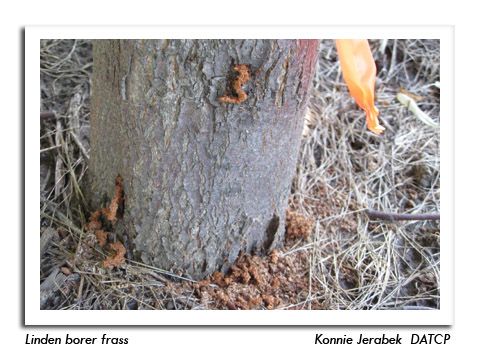
 |
|
|
Nursery & Forest
Volume 58 Number 13 Date 08/01/2013 VERTICILLIUM WILT - Catalpa trees at a nursery in Washington County were diagnosed with this fatal vascular disease, frequently misdiagnosed as decline caused by environmental factors. Symptoms are highly variable and may be acute or chronic. Acute symptoms include premature fall coloration, wilting, defoliation, branch dieback and death, whereas chronic symptoms typically reflect damage from earlier infections and may include slow growth, sparse foliage, stunted leaves and twigs, leaf scorch and abnormally heavy seed crops. Trees showing severe, widespread wilt and dieback cannot be saved, although regular watering during dry periods may reduce symptom severity. Verticillium-infected plants should be replaced with a resistant variety such as aspen, beech, sycamore, poplar, willow or any conifer. LINDEN BORER - Larvae and sawdust-like frass were observed on 'Redmond' and 'Little-leaf' linden trees in St. Croix County. This destructive wood-boring beetle attacks both vigorous and stressed nursery trees, causing structural weakening that often results in broken trunks or limbs, rapid decline and death. Early symptoms can be easily overlooked and include thinning of the canopy and bark cracks or bulges where feeding has taken place. Larger trees may not show symptoms for 2-5 years, while smaller trees may exhibit symptoms the year they are infested. Dead or dying trees may harbor large numbers of borers and should be cut down and burned or chipped before adults emerge in summer. JAPANESE BEETLE - Nursery inspectors found minor feeding damage to aronia, daylily, linden and river birch in Dane, Jackson, Jefferson, Kenosha, Racine, Walworth and Washington counties. Adults of this species skeletonize foliage, leaving only the network of veins, while the subterranean grubs feed on roots of grasses and frequently damage turf in lawns, parks and golf courses. Of the range of control measures that may be directed against the adult or larval stages (i.e. trapping, insecticides, milky spore disease, insect parasitic nematodes, etc.), none is as effective as physically removing the adults from plants in the early morning or late evening hours, when they are less active. The beetles may be killed by dropping them into a container of soapy water or by placing them in a plastic bag and freezing the contents for a minimum of 72 hours. Since peak emergence has not yet occurred, repeated chemical spot treatment of individual trees or plants may be required throughout the next few weeks for nurseries that experience high numbers of beetles. GUIGNARDIA LEAF BLOTCH - Inspectors report light symptoms of this common fungal disease on horsechestnut and buckeye trees in southeastern Wisconsin. Diagnostic characteristics are the irregular shaped, reddish-brown leaf blotches with yellow margins that twist and wrinkle affected leaves as they increase in size and number. Fungicide treatments usually are unnecessary because the impact of this leaf blotch on tree health is minimal. Fallen leaves should be collected and disposed of to reduce available inoculum that may cause new infections next spring. -- Liz Meils, DATCP Nursery Inspector NEW STATE RECORD - The "June beetles" devouring maple foliage in Door County last month were identified by UW-Madison Insect Diagnostician Phil Pellitteri as the European chafer, Rhizotrogus majalis, a very destructive grub pest of turf. This is the first confirmed report of the European chafer in the Wisconsin and a new state record. A native of western and central Europe, the European chafer was first detected in the U.S. in 1940 near Rochester, New York. Other states with confirmed populations include Connecticut, Delaware, Massachusetts, Michigan, New Jersey, New York, Ohio, Pennsylvania, Rhode Island and southern Ontario. In Michigan, the European chafer is common throughout most of the Lower Peninsula. This species is considered a more serious pest of home lawns and low-maintenance turf than Japanese beetle in areas where is established. It feeds later into the fall and starts feeding again earlier in the spring, and may even feed during warm periods in winter. Damage thresholds have been estimated at 5-10 grubs per square foot for low maintenance turf and 15-20 per square foot for daily irrigated turf. Preventive insecticides containing imidacloprid, thiamethoxam, halfenozide or clothianidin are very effective against grubs when applied in June to mid-July. These preventive treatments kill young grubs but are not as useful against larger, established grubs. -- Krista Hamilton, DATCP Entomologist 





|
|
|